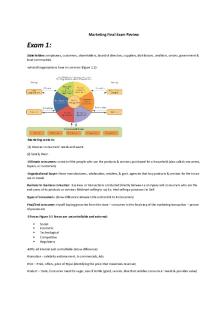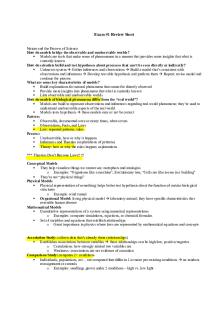Marketing 201 Final Review PDF

| Title | Marketing 201 Final Review |
|---|---|
| Author | Haley Fogarty |
| Course | Intro Marketing Mgmt |
| Institution | Drexel University |
| Pages | 3 |
| File Size | 38.9 KB |
| File Type | |
| Total Downloads | 45 |
| Total Views | 146 |
Summary
Jacob Miller...
Description
Product lifestyle Intro: product is announce, sales and revenue incline very slowly, profit is negative because $ it takes to market the product Growth: sales increase rapidly, profit peaks, competition is introduced
Maturity: sales incline at decreasing rate, peak, and decline profit declines bc of competition Decline: sales and profit decline, no need for the product anymore Mass marketing: everyone is a customer, salt and pepper Segmented marketing: separate market into groups and different offerings for each of them Niche: offerings to specific markets only, usually when resources are limited Individual, micro: one segment or individual, when companies are so specialized Marketing: Activity, set of institutions for creating, communicating, delivering, exchanging products that are worth value for customers For profit, tools and tactics to create value but main goal is to make profit Non-profit- support environment, people, children, animals use tactics and tools to create value, no goal to make money but still need to get their point across. Revenue-profit=cost Strengths-what u are good at, what u have that others dont Weakness- what u lack, what other companies have that u could use/ arent good at Opportunities- market trends, tech innovation, land opportunities Threats-financial environment, competiton, public image STP Market segmentation- dividing a market into groups with the same preferences, needs, develop segment profiles Target markets- dividing those segments, choosing the most attractive markets/segments Marketing placement- placing those segments into markets with what they could benefit from most Market segmentation: dividing the market into groups based on needs, preferences
Why? Financially Gender Race Location Income
Segmentation variables: Demographic- race, gender, income, age Pro: easy to understand, public knowledge Con: same demo have dif pref and needs Geographic- country, place, region, city, state Pro: easy to understands, help companies operate in different regions Con: same geo dif preferences and needs Psychographic- beleifs, values, lifestyles Pro: get to know the consumer, all ab them Con: expensive and time consuming Behavioral- loyalty, usage, purpose Pro: making products based on consumer wants Con: lack of innovation Targeting: Choosing consumer segments in order to focus on the marketing efforts Mass, segmented, nice, individual/local Factors that affect consumer behavior Situational- time of day, mood, something that is affect them ATM Personal- personality, gender, age Psychological- motivation, purpose, perception, attitude Societal- environment, culture, class
Self actualization- personal acception Esteem needs- recognition from others as a result of personal accomplishments Societal- being loved, accepted by people around them Safety- feeling safe from harm Physiological- food, water, sleep Purpose of market research Collection, analysis, reporting of data
To answer a question
Data: Primary- research you completed on your own, did to answer personal question (more time consuming and expensive) Secondary- research other people have done, or you have done in the past for other reasons (us census) ResearchExploratory- interviews, focus groups used to gain primary information/ why something happened Descriptive- anything you can find by observing, survey, neuroscience Casual- can answer what if questions, hypothetical...
Similar Free PDFs

Marketing 201 Final Review
- 3 Pages

Marketing Final Exam Review
- 15 Pages

Marketing Review final
- 1 Pages

ECO 201 Final Project
- 12 Pages

ANTH 201 Final Paper
- 17 Pages

ECO 201 Final Project
- 6 Pages

ECO 201 Final Assignment
- 17 Pages

Accounting 201 Exam 1 Review
- 3 Pages

Bio 201 Exam 2 Review
- 11 Pages

Marketing review
- 14 Pages

PM Final Review - Final Review
- 21 Pages

Marketing Final
- 4 Pages

ECO 201 Final Project AMD
- 11 Pages

BLW 201 Final Exam Notes
- 9 Pages

ACCY 201 Practice Final Exam
- 23 Pages
Popular Institutions
- Tinajero National High School - Annex
- Politeknik Caltex Riau
- Yokohama City University
- SGT University
- University of Al-Qadisiyah
- Divine Word College of Vigan
- Techniek College Rotterdam
- Universidade de Santiago
- Universiti Teknologi MARA Cawangan Johor Kampus Pasir Gudang
- Poltekkes Kemenkes Yogyakarta
- Baguio City National High School
- Colegio san marcos
- preparatoria uno
- Centro de Bachillerato Tecnológico Industrial y de Servicios No. 107
- Dalian Maritime University
- Quang Trung Secondary School
- Colegio Tecnológico en Informática
- Corporación Regional de Educación Superior
- Grupo CEDVA
- Dar Al Uloom University
- Centro de Estudios Preuniversitarios de la Universidad Nacional de Ingeniería
- 上智大学
- Aakash International School, Nuna Majara
- San Felipe Neri Catholic School
- Kang Chiao International School - New Taipei City
- Misamis Occidental National High School
- Institución Educativa Escuela Normal Juan Ladrilleros
- Kolehiyo ng Pantukan
- Batanes State College
- Instituto Continental
- Sekolah Menengah Kejuruan Kesehatan Kaltara (Tarakan)
- Colegio de La Inmaculada Concepcion - Cebu
